Triumph announces the official completion of the TE-1 electric development project and has released the final prototype-test results, which exceeded the project’s objectives. Daytona 200 Champion Brandon Paasch participated in the final testing phase, both in engine performance evaluation and with the final setup of the prototype through track testing:
VIDEO | Brandon Paasch and the Project Triumph TE-1 Electric Prototype
Here is the complete press release from Triumph:
Triumph announces the official completion of the TE-1 electric development project, with the release of the final prototype test results which exceed the project objectives and demonstrate the incredible success of this unique collaboration.
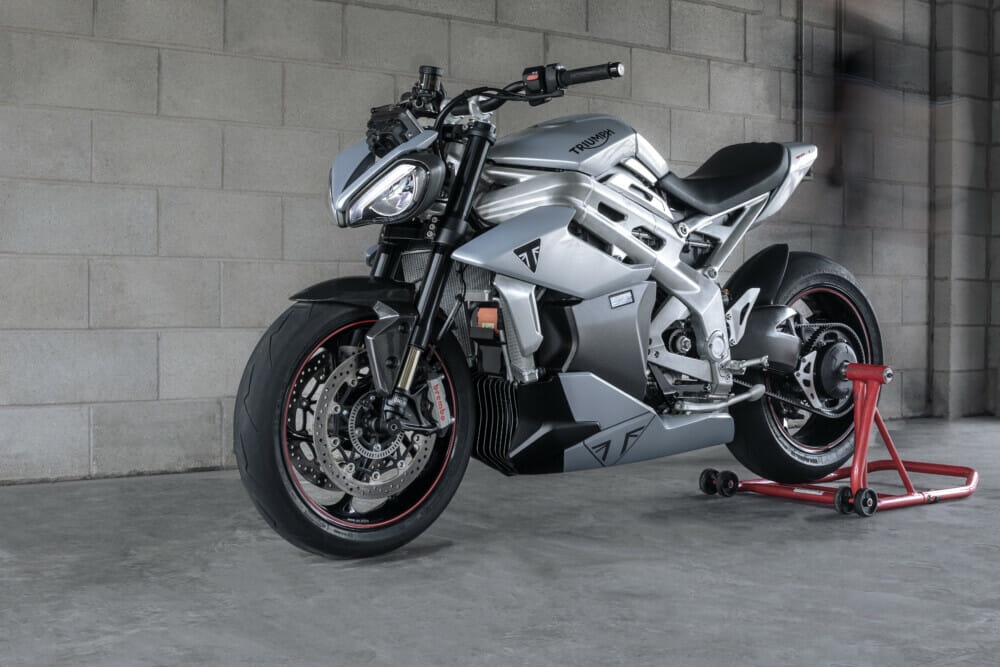
- 100 Mile Range
Significantly exceeding the real-world range of the equivalent electric motorcycles available today, with a category-leading 100-mile (161 km) range, based on live
testing and official projections
- 175 HP Peak Power (130 kW / 177PS)
The TE-1 prototype delivers an incredible standard of acceleration, achieving 6 seconds 0-60mph, and an outstanding 6.2 seconds 0-100mph
- 20-minute charge time (0-80%)
A game-changing outcome, faster than today’s equivalent electric motorcycles
- 485 lbs, with an incredible power-to-weight ratio
Up to 25% lighter than comparable electric motorcycles currently available
- Stunning final prototype that demonstrates Triumph’s class-leading USPs and hints at the exciting future to come for Triumph fans across the world
-
- Pure, unique, and characterful new electric-Triumph soundtrack that builds to a hair-raising crescendo
- The ergonomics, geometry, and weight distribution of a Speed Triple, with the scale and visual impact of a Street Triple
- Triumph’s signature thrilling feel and neutral handling, with the throttle and torque delivery map equivalent to a Speed Triple 1200 RS
- A style and presence that is 100% Triumph, with signature design DNA
The unique collaboration between Triumph Motorcycles, Williams Advanced Engineering, Integral Powertrain Ltd, and WMG, University of Warwick, funded by the Office for Zero Emission Vehicles through Innovate UK, was set up to create ground-breaking developments in specialist electric motorcycle engineering and innovative integrated technology design.
The extensive live testing program, which involved numerous assessments of the bike’s performance on the rolling road, as well as on track, provided vital direction into the final set-up and calibration of the TE-1 prototype demonstrator, which has now delivered on all its targets and objectives.
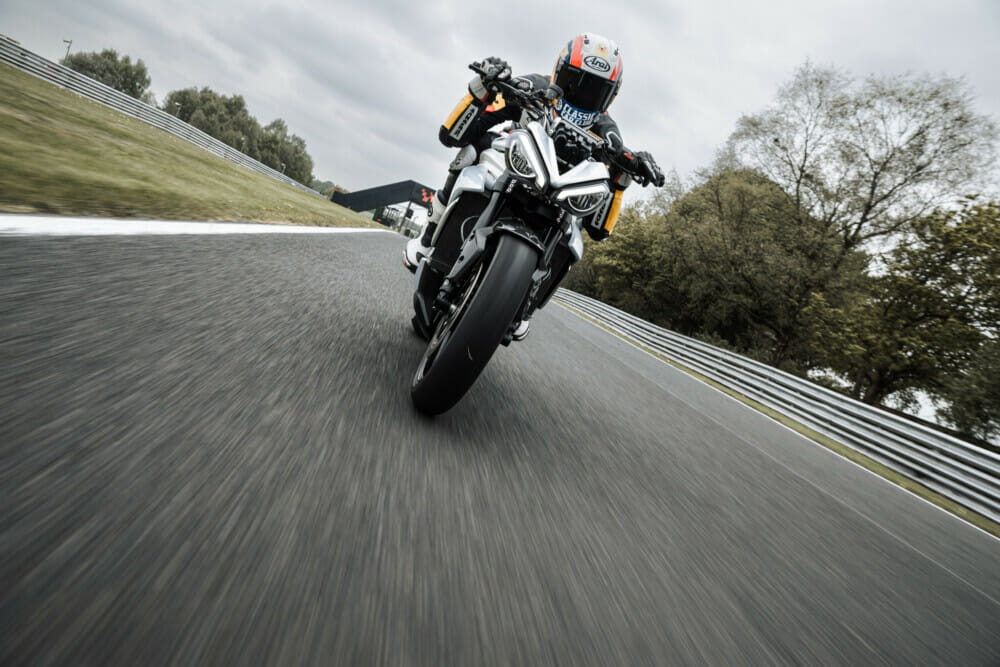
PROJECT PHASE 4 COMPLETE
Now officially complete, the live testing phase of the Triumph TE-1 project has seen the prototype demonstrator exceed expectations and achieve some incredible outcomes, delivering on all project objectives of accelerating electric motorcycle development and innovation, setting new standards for the sector overall, including final battery and range performance. The expertise and capabilities developed throughout the project now pave the way for the exciting electric future to come from Triumph Motorcycles.
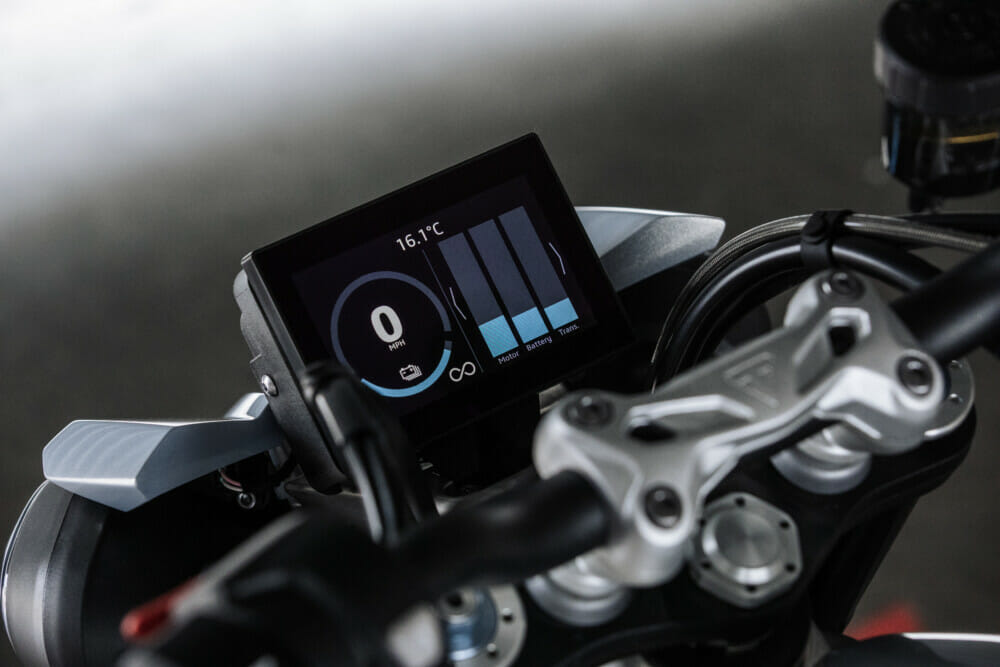
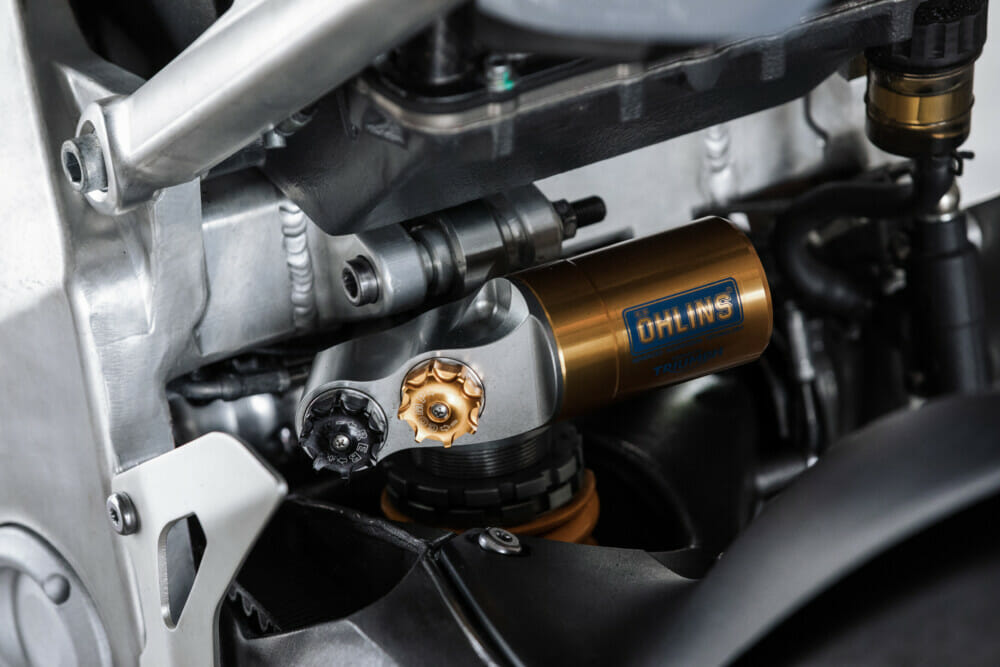
Category-Leading 100-Mile Range
Exceeding the real-world range of the equivalent electric motorcycles available today, the Triumph TE-1 prototype has achieved all project targets with regards to the energy capacity of the Williams TE-1 project developed battery, with an incredible 100-mile (161 km) range, based on official testing and projections.
Regenerative braking has been successfully implemented for TE-1, with scope for further optimization, as well as greater efficiencies in the motor generator unit and transmission, which could improve the range further for the future of Triumph electric motorcycles.
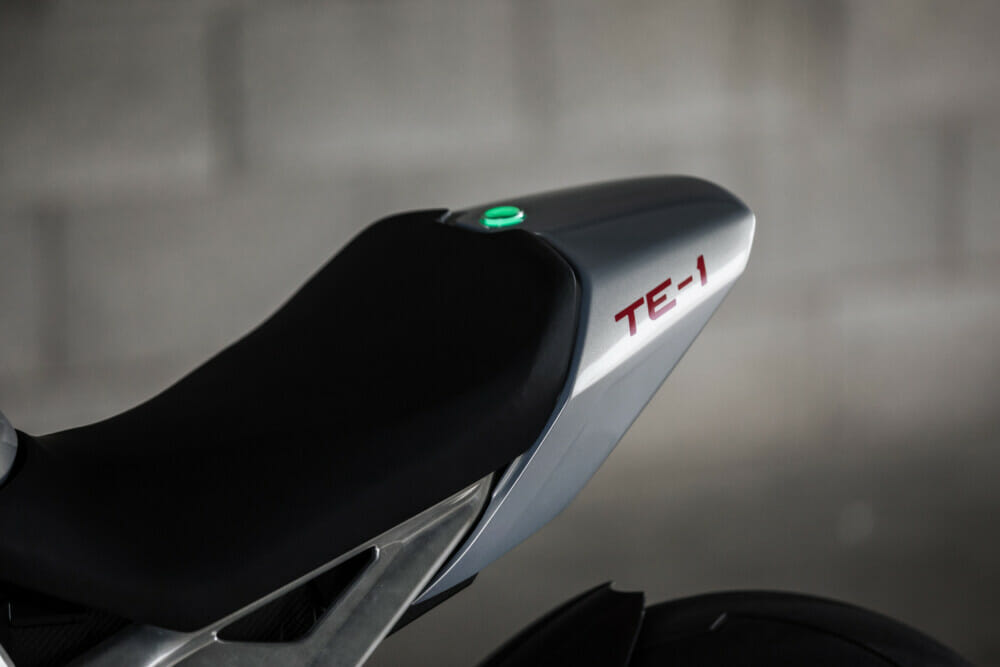
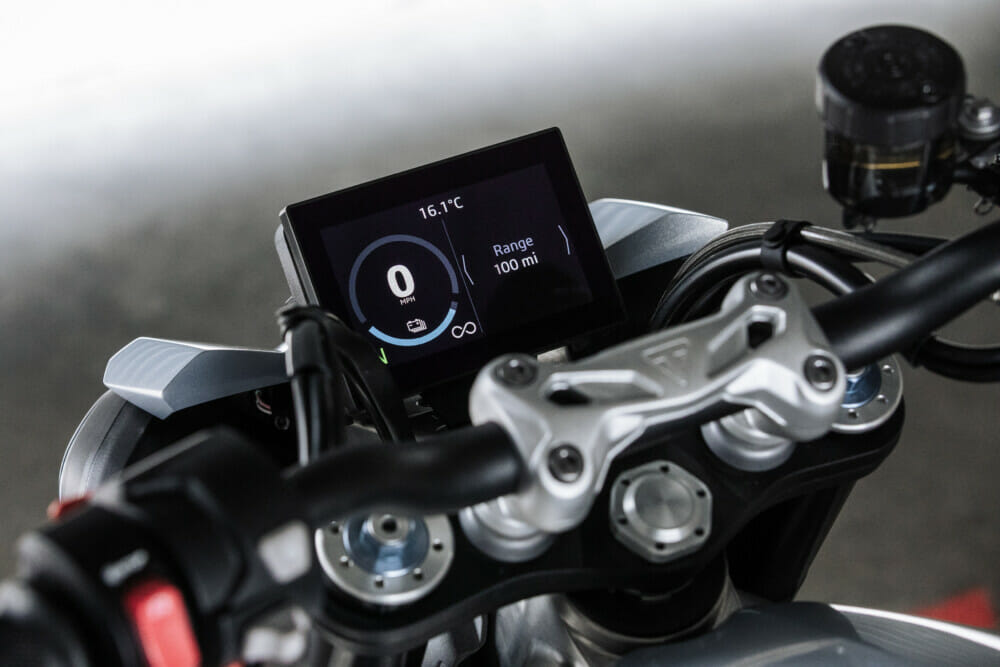
Performance that matches the Speed Triple 1200, with an even faster 0-100mph
With a level of performance similar to the current Speed Triple 1200, the TE-1 prototype delivers an impressive 175 hp (130kW / 177PS) peak power, as well as peak torque of 80 lbft (109Nm), for instant responsiveness, smooth controlled power all the way up through the rev range, and a completely exhilarating ride.
The TE-1 has also achieved an incredible standing start acceleration official test result of 3.6 seconds 0-60mph and 6.2 seconds 0-100mph.
With further refinement of the electronics, including the traction control system and front wheel lift control, the team responsible for delivering the TE-1 project anticipate that performance could be enhanced further, harnessing the full torque potential to enable even quicker standing start acceleration.
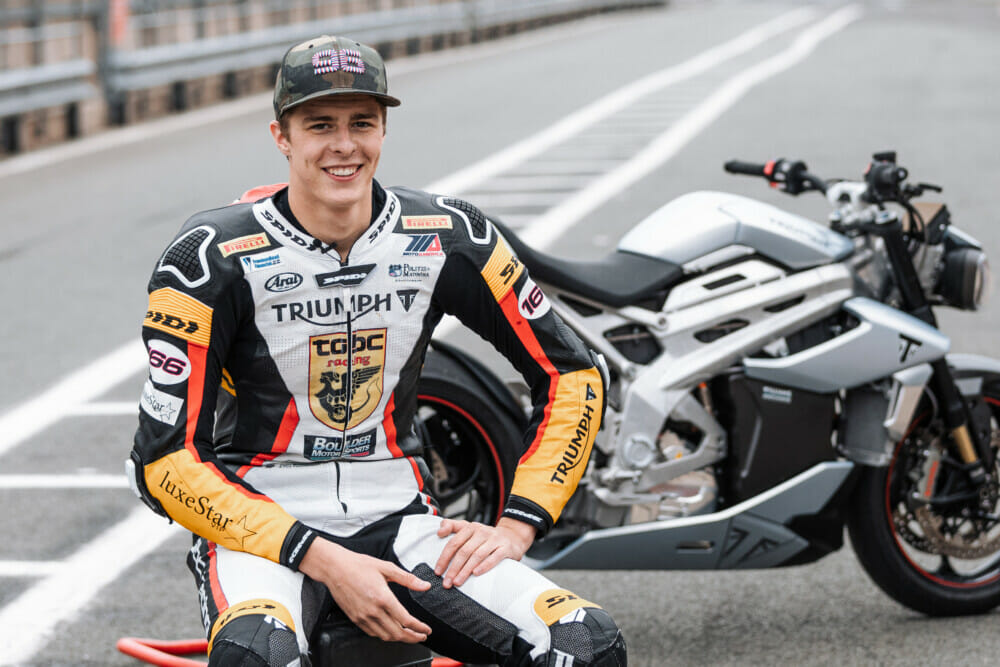
Daytona 200 Champion Brandon Paasch participated in the final testing phase, both in engine performance evaluation and with the final set-up of the prototype through track testing.
“The throttle response on the TE-1 is kind of incredible, it’s very torquey and when you first touch the throttle it’s instant power, which is obviously what I love as a motorcycle racer – I love when it’s super-torquey and picks up right away, so for me it was a really great experience”, said Brandon. “I got to peg this thing all the way from zero to 100% throttle and it’s unbelievably quick, it pulls like crazy.”
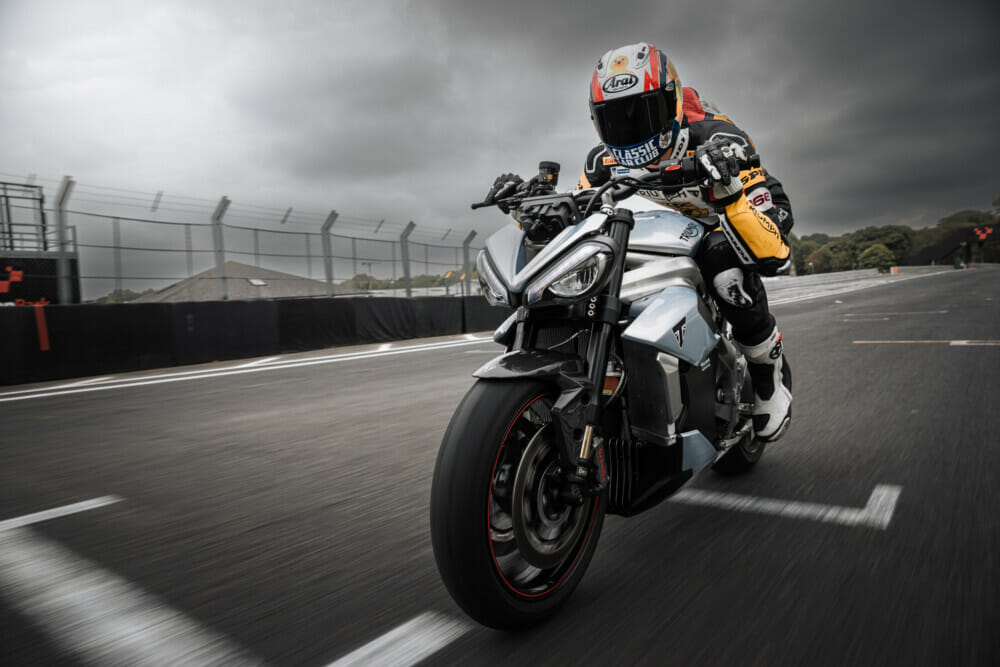
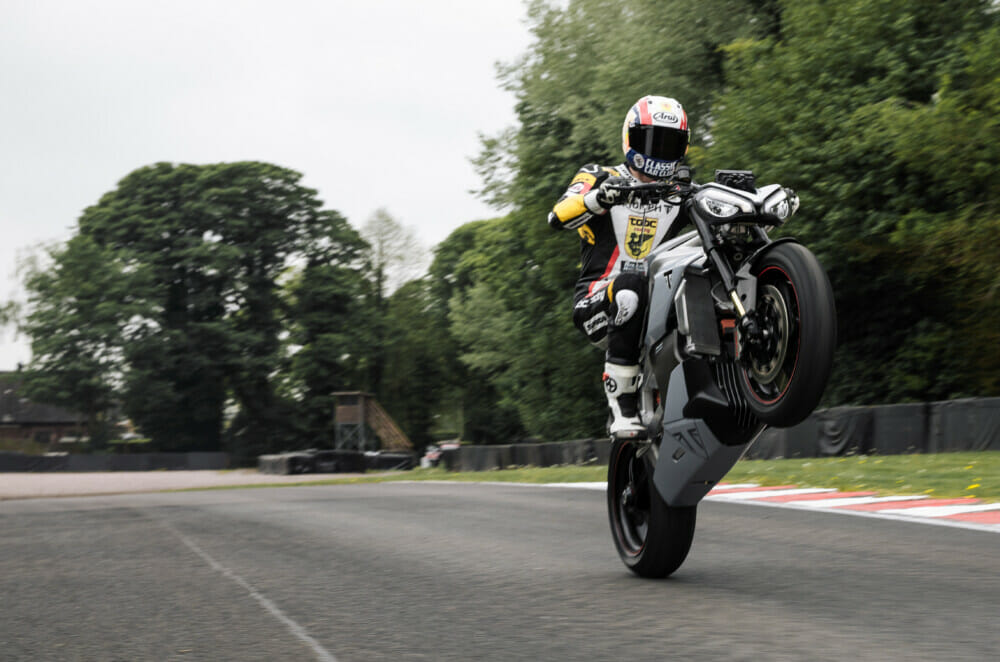
Game-changing 20-minute charge time
Advances in battery and charging technologies that have been developed as part of the Triumph TE-1 project, in collaboration with Williams Advanced Engineering (WAE), have resulted in a game-changing 20-minute charge time (0-80%), successfully delivering against the ambitious targets laid out by Innovate UK, the government’s research and innovation agency that supports business led R&D funding and UK business growth.
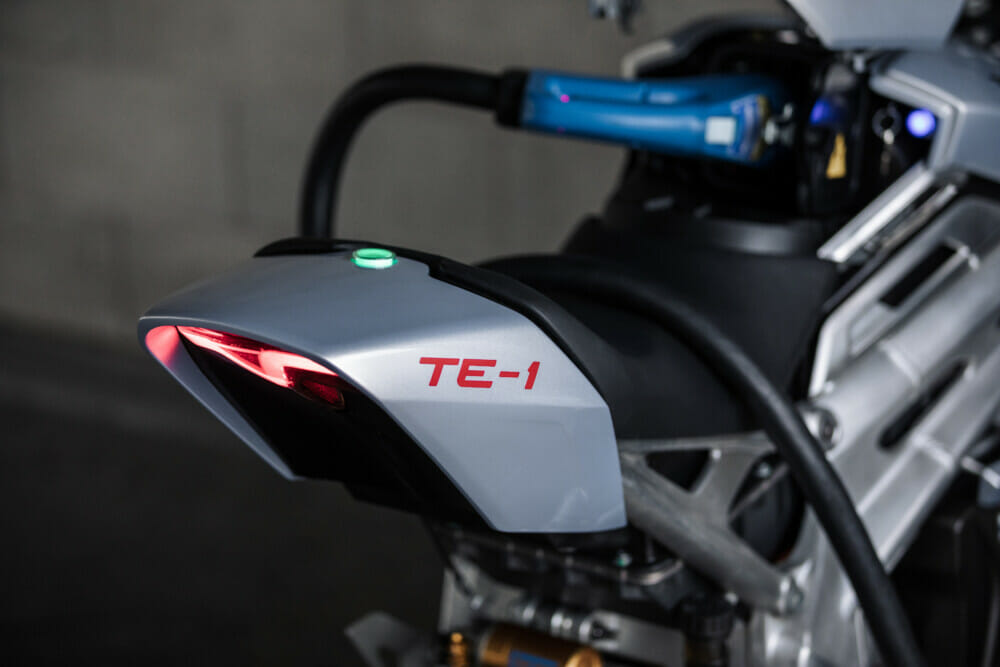
485-pound overall weight
With an overall weight of 485 lb (220kg), the TE-1 prototype is lighter than the equivalent electric bikes available currently, by up to 25%, giving it an incredible power-to-weight ratio. Having a physical size and scale comparable to a Street Triple, but with the ergonomics, geometry and weight distribution of a Speed Triple, the TE-1 delivers a completely thrilling ride, while being confidence-inspiring, nimble, and compact.
“I wish I’d had this at Daytona, that acceleration in this chassis, and how it corners – wow!” said Brandon Paasch. “I think this would be a really nice motorcycle to ride on the street, just based on how nimble and agile it is, and how light it feels.”
Triumph’s signature thrilling feel and neutral, confidence-inspiring handling
With a throttle action and torque delivery map directly engineered from a Speed Triple 1200 RS, the track testing and dynamic rider assessments on the TE-1 prototype demonstrator deliver a level of handling that matches Triumph’s current triple cylinder internal combustion sports performance motorcycles.
The TE-1’s exhilarating level of performance and acceleration, combined with its engaging and dynamic riding package, result in a bike that delivers all of Triumph’s signature feel, and world-renowned neutral handling – a smooth, predictable ride, that is agile and nimble, great in the corners, with a controllable power that incites confidence and guarantees fun.
A pure, unique, and characterful new electric-Triumph soundtrack that builds to a hair-raising crescendo
Distinctive and thrilling soundtrack, building to the most spine-tingling crescendo – the Triumph TE-1 prototype’s pure and characterful sound is considered to be more appealing and exciting than any of the equivalent electric motorcycles currently available, thanks to its unique helical gear pair primary transmission.
With noise levels tested at Mira’s external noise measurement facility, the TE-1 successfully achieved all noise standards set by the R41 homologation tests for wide open throttle, cruising and urban.
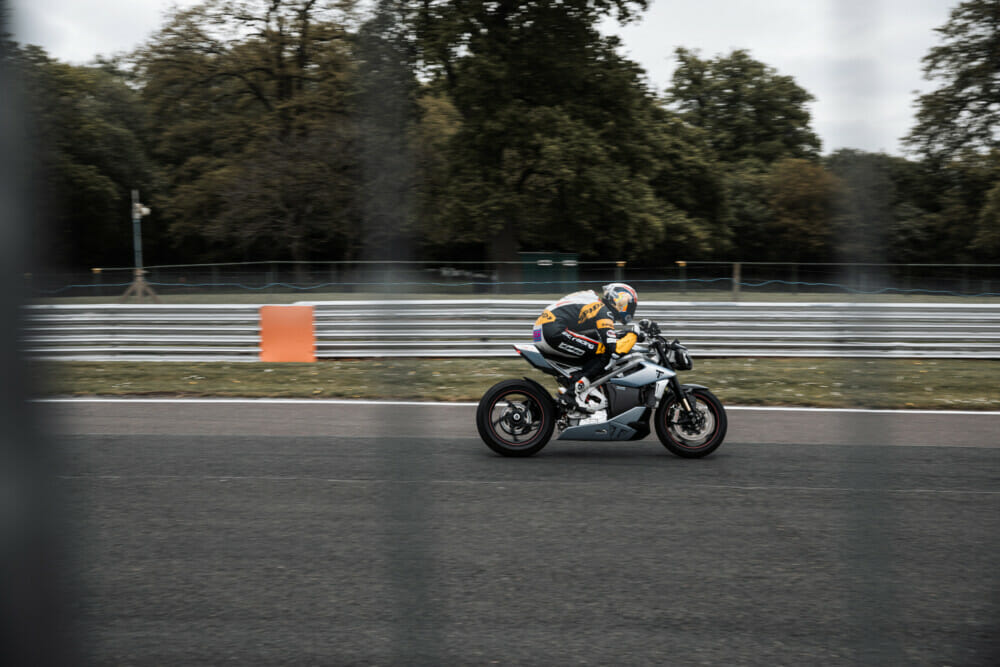
A style and presence that is 100% Triumph, with signature design DNA
Instantly recognizable as a Triumph, the TE-1 prototype’s muscular presence utilizes signature design cues from the brand’s iconic modern history of performance motorcycles, while clearly being a bike of the future. Now updated with its final body panels and paint scheme, the prototype demonstrator brings a style and presence that is 100% Triumph, with all the brand’s signature design DNA, from its aluminum frame to its distinctive twin headlights and head-down focused stance and poise.
Project TE-1 Completion
“We have already seen an incredibly positive reaction to the TE-1 prototype from motorcyclists all around the world, where many people are telling us that for the first time, they are seeing an electric motorcycle as desirable, and something that they would genuinely want to own. Being the first step in our journey towards developing our future approach to electric powertrain technology, the TE-1 prototype and the incredible results it has achieved in its intensive testing program has provided crucial insights and capabilities that will ultimately guide our future development. Of course, the final production motorcycle will not be exactly what you see here today, but rest assured, the models we do develop will encompass all its learnings and its exciting dynamic spirit.” ~Steve Sargent, Chief Product Officer, Triumph Motorcycles.
Overall, the key objective of the TE-1 project has always been focused on developing electric motorcycle capability, to provide an input into Triumph’s future electric motorcycle offering, driving innovation, capability, and new intellectual property, and enhancing the credibility and profile of British industry and design.
The achievements in the live testing phase, exceeding current benchmarks and targets, provide a platform with great potential for future development in electric motorcycle performance.
“We are incredibly proud to be able to share such positive outcomes from the completion of Project Triumph TE‑1, where the prototype demonstrator has exceeded many of our initial targets and expectations. Everyone on the team is thrilled with the results we have achieved with our partners, and how the outcomes of the project will feed into the electric future to come from Triumph.” ~Nick Bloor, CEO, Triumph Motorcycles.
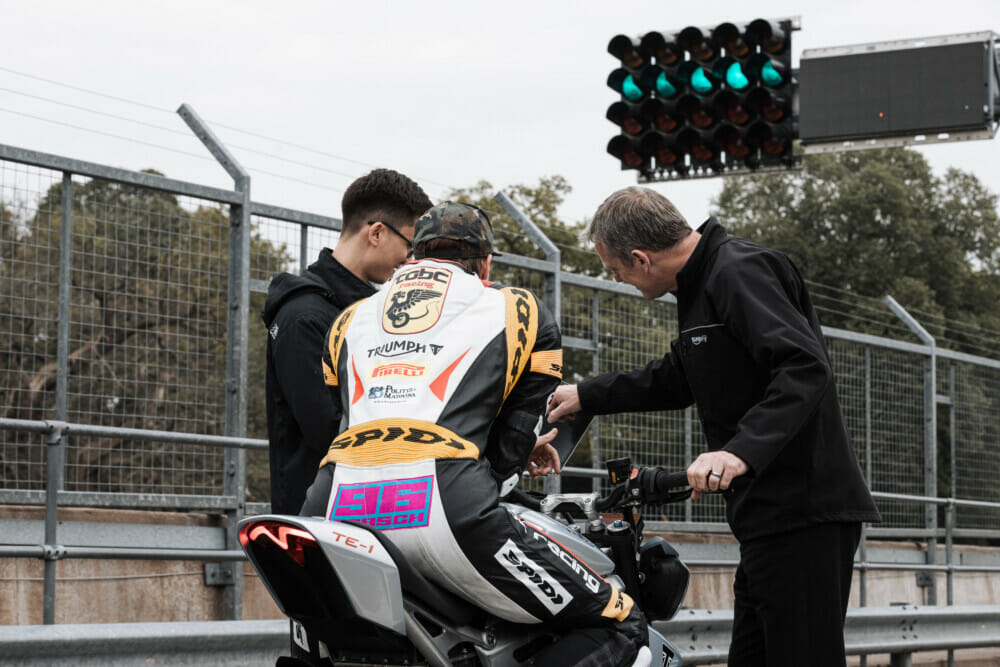
Williams Advanced Engineering (WAE) Statement:
“WAE are delighted to have been involved in this exciting program to deliver the TE-1 prototype. Since its conception in 2018, all the partners have worked with collaboration, innovation, and passion to bring the boundary breaking prototype to life. It is pleasing to hear positive rider comments which confirm that the dynamics of the bike are aligned with Triumph’s DNA. This has been underpinned by the class leading Battery and Control System that WAE has produced within a lightweight and integrated package. This core WAE technology has allowed us to exceed performance and charging targets for the battery which we look forward to seeing in future powertrains.” ~Dyrr Ardash, Head of Strategic Partnerships, Williams Advanced Engineering.
Integral Powertrain Ltd.’s E-Drive Division Statement:
“We’re delighted to see the final TE-1 motorcycle testing phase completed and with that, further validation of the performance and efficiency of our Scalable Ultra-Integrated Motor and Inverter.
For the TE-1 application, the motor has achieved peak and continuous power densities of 13kW/kg and 9kW/kg respectively; 60% higher than APC technology roadmap targets for 2025. All this has been achieved using materials and processes compatible with volume automotive production and on a length scalable motor platform. The motor scalability concept deployed on TE-1 has provided a springboard for a new scalable motor architecture, to be announced later this year, which will provide similar performance levels but much greater manufacturing scale than previously.
The ultra-integrated inverter concept, also scalable such that the number of Silicon-Carbide power stages increases for larger diameter motors has really delivered on performance (capable of >500kW) and gives us the opportunity to optimize for production or meet much higher power requirements.
We’re really proud to have been a key part of this exciting project which has been a landmark for electric motorcycles and British industry.” ~Andrew Cross, Chief Technology Manager, Integral Powertrain Ltd.
WMG, University of Warwick Statement:
“To meet our ambitious emission reduction targets in the UK we will have to rethink the way we travel, not only transitioning from ICE to electric propulsion vehicles, but also encouraging a modal shift away from private cars. Electric two wheelers have a pivotal role to play in the transport revolution as a zero-tailpipe emission option.
In our partnership with Triumph, WMG used our research experience in electrification to demonstrate manufacturers can deliver products with a lower emission burden as well as outstanding performance-offering customers an EV that is great fun to ride.” ~Prof. David Greenwood, CEO, WMG centre High Value Manufacturing Catapult, University of Warwick
Update from February 2022:
Triumph announced that Phase 3 of its TE-1 project has now reached completion.
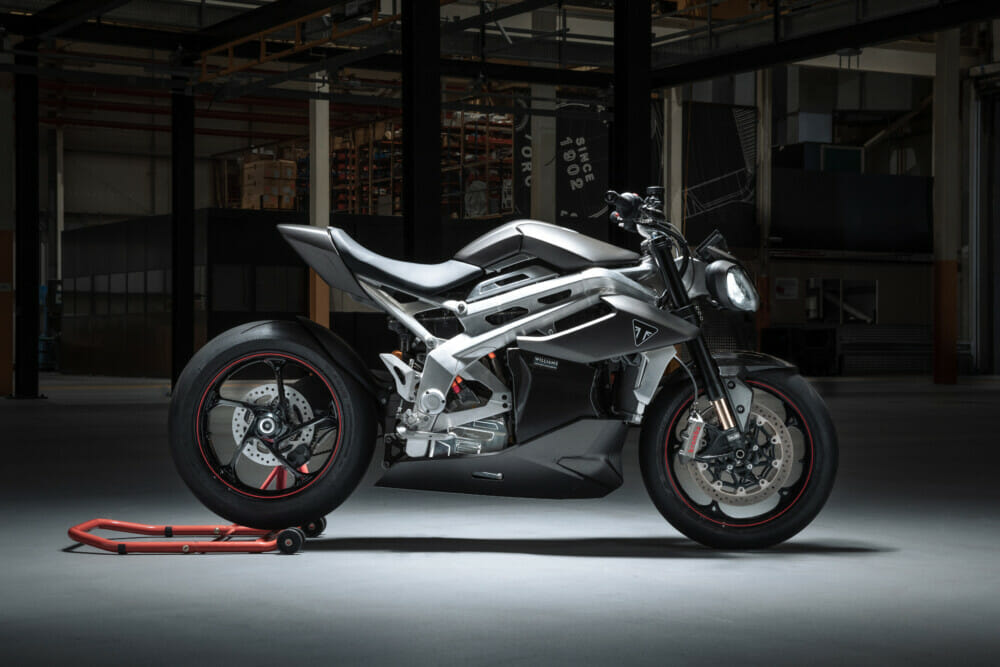
Today marks the official end of the collaboration stage of the TE-1 project, with the completion of the prototype demonstrator, which is now fully ready for the next Triumph-led stage of the project to begin – the live testing program.
The unique collaboration between Triumph Motorcycles, Williams Advanced Engineering, Integral Powertrain Ltd, and WMG at the University of Warwick funded by the Office for Zero Emission Vehicles through Innovate UK, was set up to create ground-breaking developments in specialist electric motorcycle engineering and innovative integrated technology design.
PROJECT PHASE 3 COMPLETE
Phase 3 of the TE-1 project has now reached its completion, with the final build of the prototype demonstrator. Integrating for the first time all of the latest and final innovations from the project partner workstreams, the prototype demonstrator features:
- Triumph: final chassis, including frame, rear sub-frame, cockpit, panels and wheels, final drive system including transmission and Gates Carbon belt drive, electronics, Öhlins USD cartridge forks, unique prototype Öhlins RSU, Brembo M50 monobloc calipers, and Triumph motorcycle control software
- Williams Advanced Engineering: final iteration of prototype WAE battery pack incorporating dedicated cell packaging for optimum center of gravity, vehicle control unit, DCDC converter, integrated cooling, charge port, and styled carbon covers
- Integral Powertrain: final prototype powertrain with scalable integrated inverter and combined motor with silicon carbide switching technology and integrated cooling
- WMG, University of Warwick: final pre-live trial simulation completed, with all results indicating that the project is on course to deliver the intended performance and durability outcomes
Key project achievements during this phase include test results that exceed current benchmarks and targets set by the UK Automotive Council for 2025, providing a platform with great potential for future development in electric motorcycle performance.
The overall objective of the TE-1 project has been focused on developing electric motorcycle capability, to provide an input into Triumph’s future electric motorcycle offering, driving innovation, capability, and new intellectual property, and enhancing the credibility and profile of British industry and design.
VIDEO | Project Triumph TE-1: Prototype Reveal
PROJECT PHASE 4 TO COMMENCE
With the completion of the prototype demonstrator, the full live testing phase of the TE-1 project can now begin (phase 4). Over the next 6 months the prototype demonstrator will undertake an extensive live testing program within Triumph’s state-of-the-art facilities, which will encompass:
- Rolling road testing – core functional assessment to include the following:
- Throttle calibration
- Powertrain performance mapping
- Power and torque output
- Range and battery consumption assessment
- Rider mode development
- Software functionality validation
- Thermal optimization
- Track testing – encompassing dynamic rider assessment to include the following:
- Handling
- Acceleration
- Braking and braking regeneration strategy
- Traction control
- Front wheel lift control
The testing program has been designed to provide direction into the final set up and calibration of the prototype demonstrator.
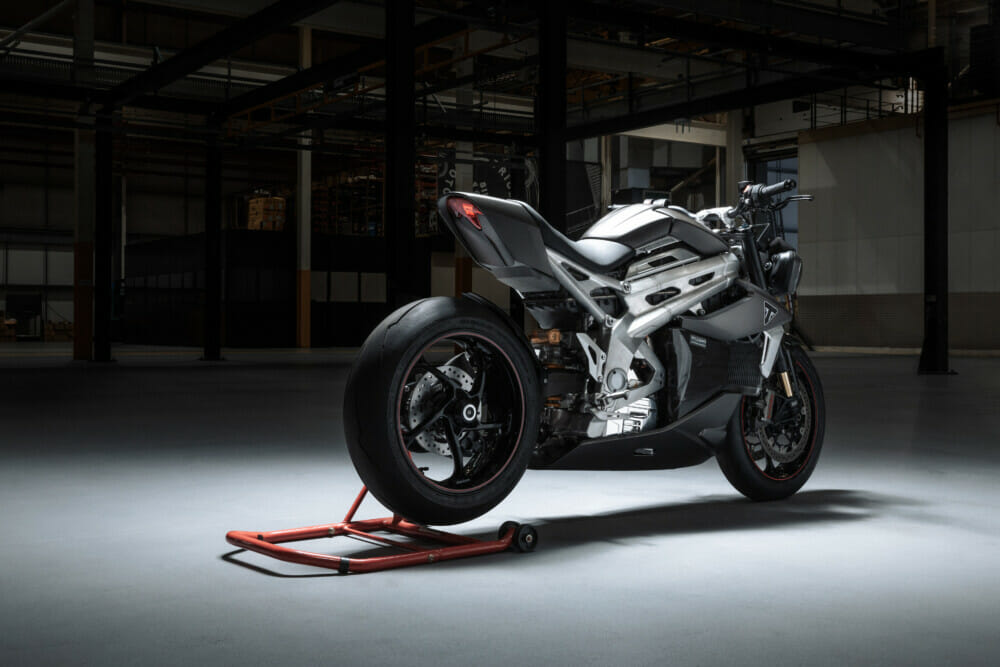
PHASE 4 COMPLETION: Summer 2022
At the completion of the live testing phase, estimated to be Summer 2022, the prototype demonstrator will be updated with its final body panels and paint scheme, in preparation for active track demonstration, and media engagement. At this time, the full results of the project including the final specifications and testing outcomes will be published, as well as insights and key facts on how the TE-1 delivers on the project targets for innovation and sets new standards for the motorcycle sector overall, including final battery and range performance. This will be supported by an opportunity for the media to talk to the team, see the prototype in action on track and hear from the development test riders.
“It has been truly exciting to see the progress made during phase 3 of Project Triumph TE 1 with the final prototype motorcycle now going into real life testing. Everyone involved at Triumph are proud to have been part of this innovative British collaboration. Personally, I am thrilled with the results we have already achieved with our partners, and the exciting preview of the potential electric future to come.” said Nick Bloor, Triumph CEO. “We look forward to continuing the ambitious and innovative work on the TE-1 demonstrator prototype through the live testing phase and sharing the outcome with Triumph fans across the world.”
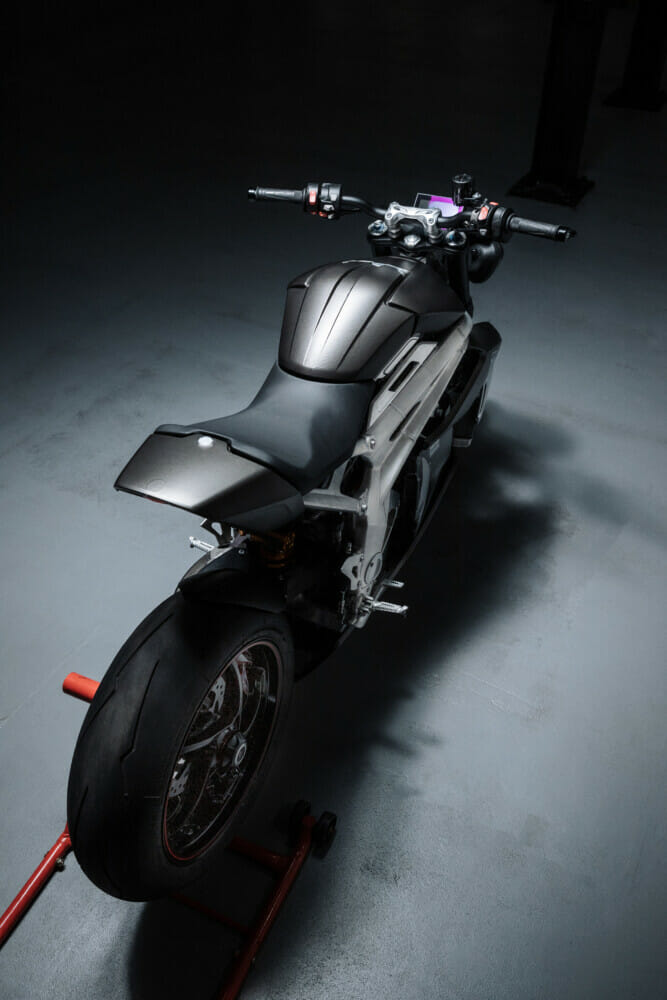
PROJECT TE-1 – PHASE 3 OUTCOMES
Demonstrator Prototype
TRIUMPH MOTORCYCLES
The Triumph TE-1 team began phase 3 by successfully building an initial mule bike which incorporated the battery, inverter, motor, and chassis into one machine for the first time. Using this platform, all the project partners worked collaboratively to optimize software integration across the complex systems, involving hundreds of hours of detailed testing to ensure the functionality of all the features and software aspects behave accurately and intuitively, as a customer would expect. This was validated in real life simulation work carried out at WMG, involving detailed powertrain rig testing and simulations to assess safety critical items relating to motor function and vehicle control. Durability testing on the primary transmission has also been conducted to ensure a full understanding of the fundamental differences in electric motor load application for vehicle use cases, efficiency, and consequences to gear life. Alongside this work, the Triumph-led design of the bespoke chassis has focused on delivering the phase 2 styling intent as closely as possible. Phase 3 of the project is now complete with the fully assembled TE-1 demonstrator prototype, the photographs of which are revealed for the first time today.
Steve Sargent, Triumph’s Chief Product Officer said “During phase 3 we have focused on building the physical foundation of Triumph’s first electric prototype motorcycle. I am pleased with the outcome of Triumph and the TE-1 partners’ efforts in creating a demonstrator bike that is not only visually so desirable with clear Triumph DNA, but also packaged with an exhilarating and thrilling brand-new electric powertrain that has such potential for the future. I look forward to continuing the development of this demonstrator vehicle through phase 4 and using our knowledge and capabilities to bring all the partners’ cutting-edge technology together into a final result which will guide Triumph’s electric strategy for the future. Our experience tells us that at this stage of a project there is no substitute to genuinely riding a bike when developing driveability, handling, and character, and we have ambitious targets focused on delivering a riding experience that is new and exciting, but ultimately intuitive and familiar. I am really looking forward to my first opportunity to ride the completed prototype.”
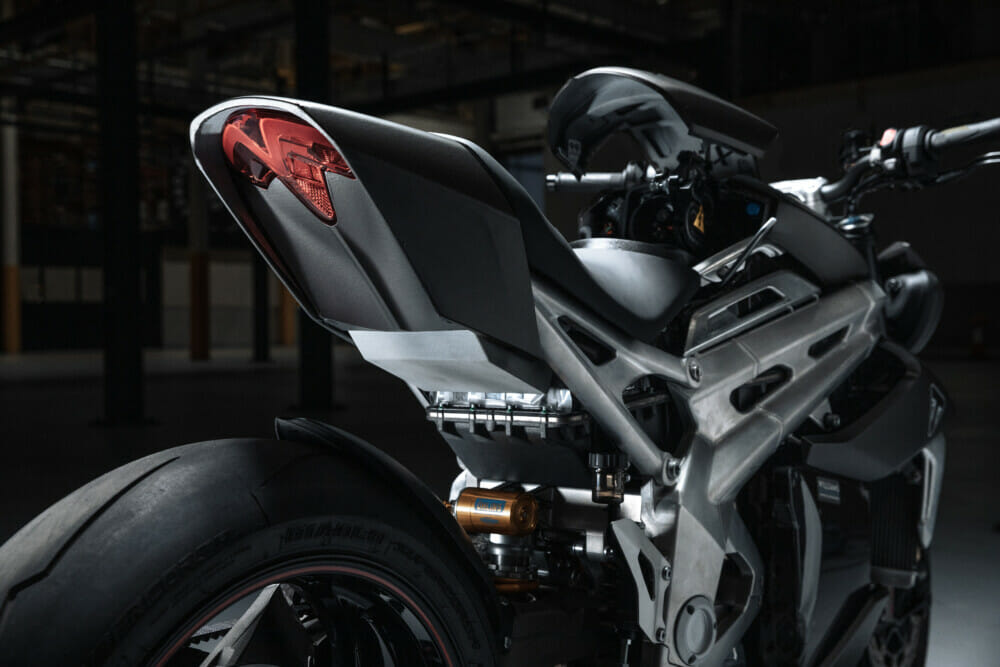
WILLIAMS ADVANCED ENGINEERING (WAE)
Following completion of Phase 2 of the program in March 2021, which delivered a fully bench tested battery, Williams Advanced Engineering have now concluded work on Phase 3 which contained some critical gateways for the project.
In addition to supporting a number of hardware and software solutions; specifically integrating Triumph’s motorcycle control software to work in harmony with WAE’s controller and battery management system, the team has enhanced the integration of the mechanical and electrical solutions; optimizing battery layout to balance mass and positioning within the chassis.
The demonstrator bike is now undergoing final battery level validation and calibration to ensure the performance results meet best-in-class power and energy density targets and for the rider, ensuring there is no compromise in performance at low levels of charge.
“Following an extended period of testing, we are thrilled to finally see the results of our work on a physical bike. By working with the team at Triumph, we have continued to push the boundaries of battery technology, keeping the rider in mind at all times” said Dyrr Ardash, Head of Strategic Partnerships, Williams Advanced Engineering “Because we have designed the battery from the ground-up, design has not been compromised and we have been able to push the boundaries of current technology, offering both performance and all important, range.”
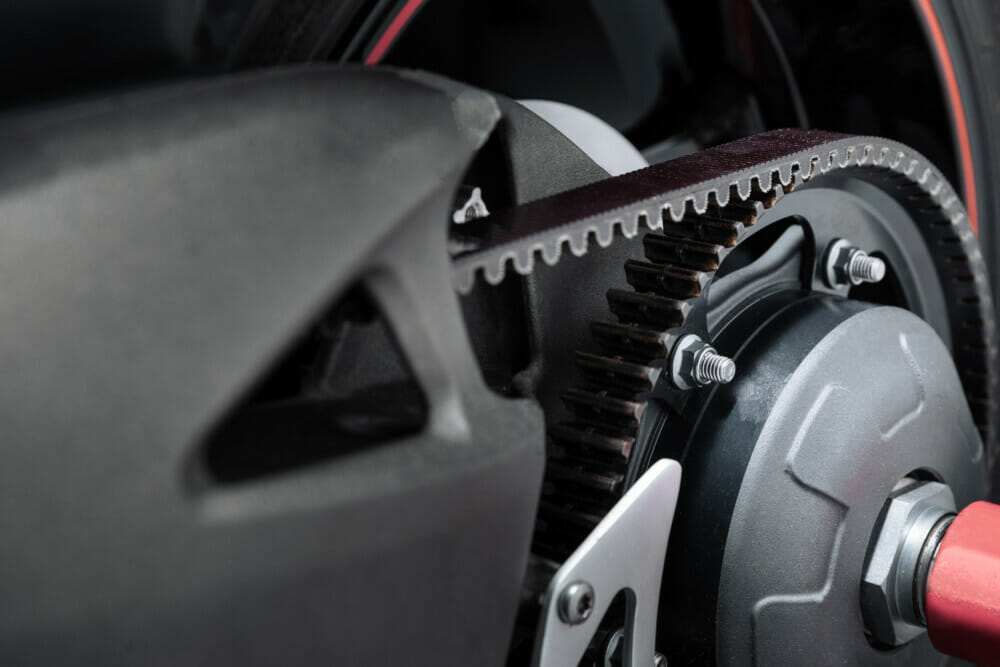
INTEGRAL POWERTRAIN LTD.’S E-DRIVE DIVISION
“We are absolutely delighted to complete our part in this project and deliver what we set out to achieve which is a scalable, ultra-highly integrated motor and inverter, with no phase cables, busbars, or separate cooling circuits. For the TE-1 application, the motor achieves peak and continuous power densities of 13 kW/kg and 9 kW/kg respectively which is 60% higher than new APC technology roadmap targets for 2025. All of this has been achieved using materials and processes compatible with volume automotive production and importantly using a length scalable motor platform.
“The inverter concept, which is also scalable by tuning the number of Silicon-Carbide power stages for different diameter motors, has really delivered on performance. The TE-1 unit is capable of >500kW! This gives us the opportunity to optimize this platform for production.
“The integrated motor and inverter unit is now on the bike and is delivering on the target performance and cycle efficiency we engineered, modelled and simulated to achieve. We’re very much looking forward the feedback from bike-level testing and the benefits of our high efficiency on range.
“We’re really proud to have been a key part of this exciting project which has been a landmark for electric motorcycles and British industry.” Andrew Cross, Chief Technical Officer at Integral Powertrain Ltd.
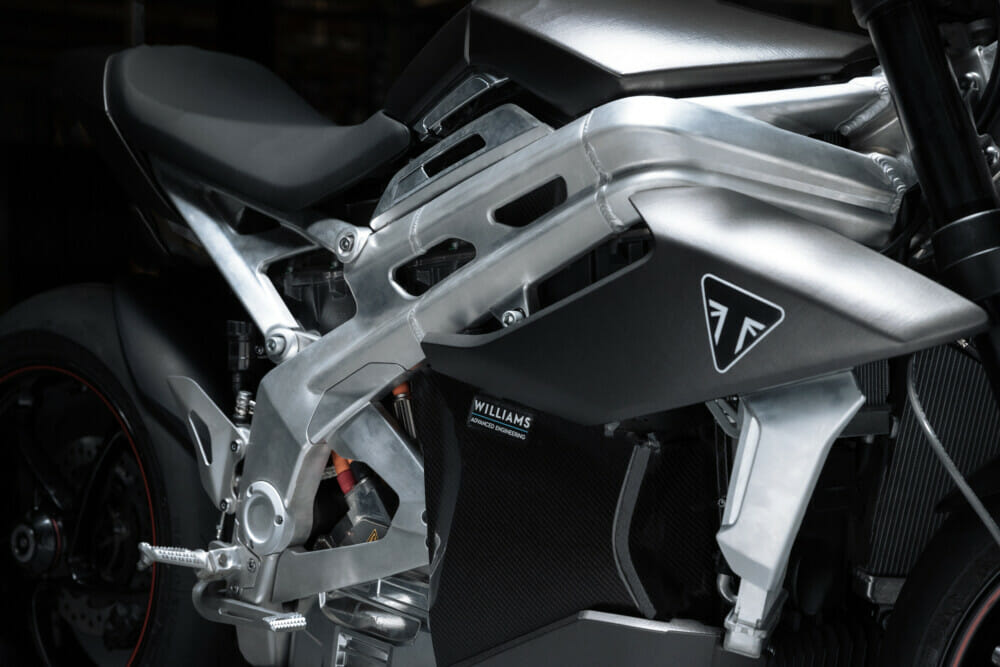
WMG, UNIVERSITY OF WARWICK
“WMG has been working closely with Triumph to support the development of the motorcycle control unit via a comprehensive real-time evaluation process using two bespoke physical rigs. A 3D physical motorcycle model has been created and integrated with the first rig to allow the evaluation and refinement of the control unit under real-world driving scenarios, ensuring it behaves well before the integration into the initial prototype bike. The second rig has been utilized to support Triumph in evaluating the power and energy performance of the whole drivetrain as well as confirming its durability. We have also focused on control research and development at other levels, including advanced traction control and optimal brake blending strategies. The findings in energy system modelling, simulation and control, especially real-world case studies with electric motorcycles, gained through this TE-1 project have been utilized to develop teaching materials on energy systems, hybridization and electrification technologies across education programs at WMG.” Truong Quang Dinh, Associate Professor of Energy System Management and Control at WMG, University of Warwick.
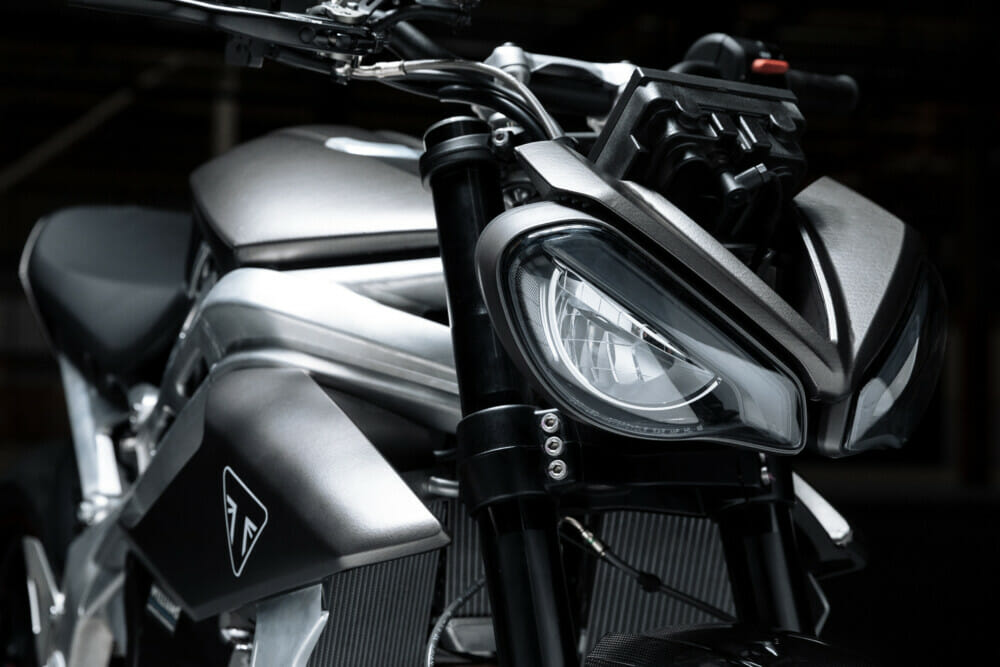
“WMG has also been helping Triumph understand the opportunities and wider implications of electrification towards their business. This has included investigating the opportunities for electric two-wheeler charging networks, the need for domestic electric motorcycle recycling, the necessity to develop local battery supply chains and the direction that Triumph will need to take to ensure that they can design, develop, manufacture, and distribute electric two-wheeled vehicles in the future. The findings from these studies are also providing direction to national and local governments, specifically around areas where policy intervention can support electric motorcycle adoption.
“In many studies undertaken by WMG, bespoke computer-based models developed at the university (such as the university’s own UniWarp software), have been instrumental in understanding the best possible direction or action required for different scenarios. This approach has enabled WMG to quantify the environmental impact of electric motorcycles and has defined methods by which this can be further improved through new vehicle features, vehicle system sizing or new external collaborations.” Jim Hooper, Principal Engineer of Electric Vehicle Projects at WMG, University of Warwick.
Click here for more Triumph motorcycle reviews and news.
